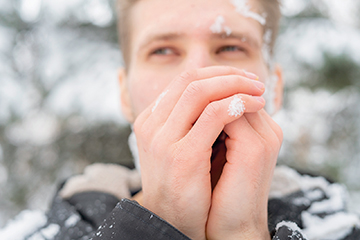If part of your body has frozen from spending time outdoors on a cold day, here are some dos and don’ts to follow.
What to do
Follow these steps if you think you have frostbite:
• Go inside and sit down in a comfortable chair.
• Gently remove anything covering the affected area, such as boots, socks or gloves.

• Warm the affected area gradually with your hands
or another part of your body, such as your armpits
or stomach. Don’t press too hard.
• Immerse the affected area in warm water.
• Gently wiggle the affected joints to stimulate
blood circulation.
What NOT to do
Here’s what NOT to do if you suspect you have frostbite:
• Don’t rub the affected area.
• Don’t use a heating implement such as a space heater or fireplace to warm the area.
• Don’t put pressure on the frostbite. If you have frostbite on your toe, avoid walking on it.
Once your skin has warmed up, the affected area may become numb, swollen, hot, sensitive or even painful. If you’re in a lot of pain, go to a pharmacy and get an over-the-counter analgesic.



